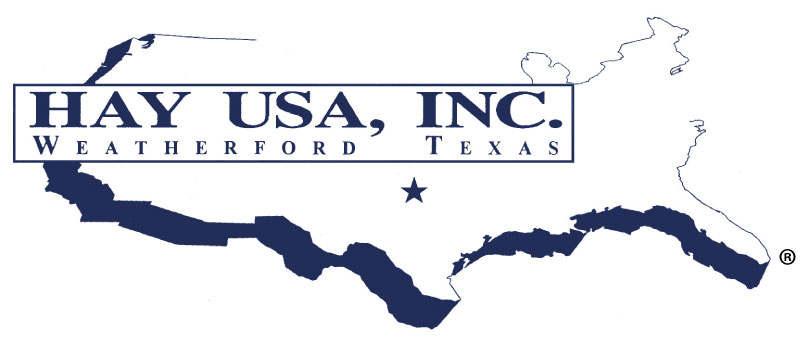
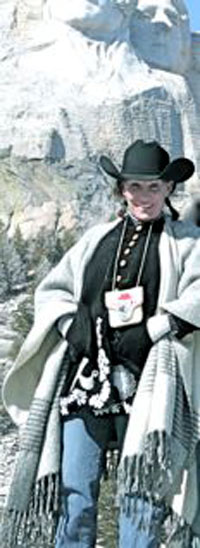
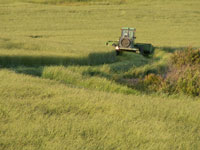

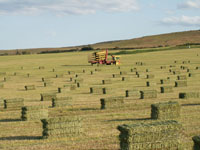
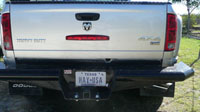
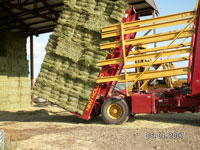

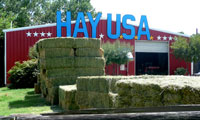
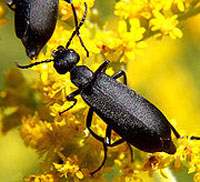
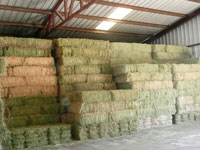
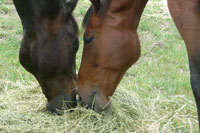
Welcome to the Hay USA Inc. Web site.
People often ask us. . . Why west coast hay? When did you come to Texas? What brought you to Texas? How did you start selling hay? What did you do before you sold hay? How did you end up in Weatherford, Texas of all places in the country?
Let me do my best to answer a few questions with a story.
My name is Liz Blitzer and I have been established in the hay industry since 1989. Previously, I owned a collectable bit, saddle, and spur shop in Burbank, California called Cowboys and Indians. My shop was a second home to the who’s-who of old Westerns: Dick Farnsworth from The Grey Fox, Barry Corbin in his “Lonesome Dove” days, and Buck Taylor from “Gun Smoke”.
One day, my friend John Schneider (“Dukes of Hazzard”) came into my shop and said, "I have a friend in Colorado who farms alfalfa. Do you want to try and sell it?”
That one question was the beginning of my new future.
I had horses and I was feeding them hay every day, so I was familiar with the product. I tried to sell that Colorado alfalfa, but because I had no connections or experience, I was unsuccessful.
But, I wasn’t ready to give up.
So, I let my fingers do the walking and I made a phone call to a hay dealer named Tony Schoneveld. He had a warm, jovial voice, and I said to him, "I always wanted to be a hay dealer when I grew up." He replied, "If you're serious, meet me in Banning, California tomorrow at 4:00 AM at the Arco station.” I was up at 1:00 o’clock in the morning because I had a two-hour drive ahead of me. It was 126°F in the shade as he took me from stack to stack in The Imperial Valley, California. At the end of the day, he tried to hire me. I insisted on staying independent, and asked if he would be my supplier and teacher. He agreed.
Tony was a tough teacher when it came to premium hay. He would carry around a two-by-four like a walking stick and keep a playing card in his front shirt pocket. I dreaded the moments when he would say, “If I can put this playing card between the stick and the stack, you’re re-stackin’ the whole thing, kid.”
We agreed that I would make $2.00 per ton selling semi-loads that averaged 24 tons. That was about $50 a load, and I was thrilled! The deal was, I would pick up four sample bales a week, which cost me $5 a bale, and those were the loads I needed to sell. Tony’s offices were 60 miles away from my home in the Los Angeles Basin. There was no such thing as cell phones, I had no gas allowance, and I had no hay sales experience. It was time to put the hard work in.
As I drove home from Banning that first day, absolutely exhausted at the end of a 500-mile day, I knew I needed to get business cards printed before I started selling door-to-door. First, I had to come up with a company name. I needed a strong name that rhymed, that everyone could remember… What rhymes with Hay? “USA.” Hay USA. The journey ahead was not nearly as easy as coming up with the name.
My first attempt to sell a semi-load of hay was to a man named Glen Randall, who trained Trigger for Roy Rogers. He introduced me to Danny Allen, a Western movie prop master who cared for all of the white horses and chariots that were in Ben-Hur. My learning experience during this time was amazing, but my sales were nonexistent. I only survived thanks to my shop, Cowboys and Indians, and the incredible support of my family. They recognized the hard work and commitment I was investing into Hay USA as a reflection of the values they had always instilled in me.
I lived in an equine neighborhood, and as time progressed, my neighbors started asking me for hay. So, I decided to bring a semi-load of alfalfa, from Tony, to my home. I sold the load bale by bale, just like I do today. No more driving door-to-door and wishing I could afford a cell phone! I soon realized that I needed someone to help me deliver the hay. That’s when I hired Bill Hartman as my deliveryman, and together we built a profitable business over the next few years.
During that time, some of my California clients were showing their horses in Fort Worth. They came to me and informed me of the danger of blister beetles in alfalfa from the Southwest (https://www.hayusa.net/blister.html). They explained that it was impossible to get premium, safe hay from that region. After dozens of phone conversations with entomologists around the country, I knew that was my new path. So, I decided to sell Hay USA in California in 1992 and move forward to the greener pastures of North Texas. Unfortunately, the new owners went against every business theory that my family ever taught me: “if it’s not broke, don’t fix it.” They changed the quality of the hay, changed suppliers, changed locations, and, they even fired Bill Hartman! To top it all off, I never got paid. So, within one year, they lost Hay USA in California.
There was no looking back. Off to Texas I went, where I landed in Wise County. I found a beautiful house in the country. It had it all: stables, acreage, a modest price tag, and some interesting neighbors. When I say interesting, I mean scary. I BALED! (pun intended)
I left Texas and drove 11,000 miles around the country, with three horses, two dogs, two cats and a goat, in search of the perfect place to ply healthy hay and recreate the business I had in California.
But I realized, after making my way from Tennessee to Wyoming, that my specialty of premium, safe hay was more of a necessity in Texas than anywhere else. So we hoofed it back to Texas and settled in Weatherford, because it is the Cutting Horse Capital of the world..
I found a building and called on a dear friend in California who was a set designer in the movie industry. He drove to Weatherford, tools in hand, to help me create a new and improved Hay USA. His amazing artistic eye and talent made Hay USA at 1714 Blair Drive the unforgettable place it is today. We officially opened for business in Texas in October of 1994.
All the odds were against me: I was an outsider, competing with local hay producers who had been growing hay for generations. Their hay was inexpensive and familiar. I started shipping three-string bales of California alfalfa to Weatherford, Texas. There was a group of older men, local farmers and ranchers, who had coffee every morning at the Stock Yards Cafe. They told me they had a running bet that I would never make it. I was gonna prove them wrong. I was staying.
Seven days a week, nine hard working people in hay chaps and gloves wrestled semi-loads of 130-pound bales. I was on the road consistently, selling door-to-door again, bringing in new business and educating people on three-string hay that was premium quality. It was a hard sell. People could not understand the heavy bales, and refused to do the math and see the savings. So, I compromised, and started shipping in alfalfa from Arizona. It was considerably less per ton compared to the California hay, and the shipping was cheaper. The hay looked beautiful and green, plus the bales were lighter and easier to handle at 100 pounds. I was supplying a high volume of hay nationwide to many ranches.
Then it happened: I was at the farm in Seven days a week, nine hard working people in hay chaps and gloves wrestled semi-loads of 130-pound bales. I was on the road consistently, selling door-to-door again, bringing in new business and educating people on three-string hay that was premium quality. It was a hard sell. People could not understand the heavy bales, and refused to do the math and see the savings. So, I com-promised, and started shipping in alfalfa from Arizona. It was considerably less per ton compared to the California hay, and the shipping was cheaper. The hay looked beautiful and green, plus the bales were lighter and easier to handle at 100 pounds. I was supplying a high volume of hay nationwide to many ranches. Arizona and with my own eyes I saw blister beetles. That day, I stopped selling Arizona hay. I contacted every client and put my business on hold.
I headed west for California and went back to my original Hay USA formula of premium California hay with no compromise. I learned that no matter how hard it is to sell, California hay is the safest hay available. I had a meeting with an entomologist there and reconnected with my former suppliers and my mentor Tony. I started shipping California hay to Texas again, as well as timothy hay from Oregon and Washington. I focused on teaching people about the financial advantages of buying premium hay to avoid blister beetle deaths and colics.
It's been a long road filled with great learning experiences and hard work. Our loyal clients have been local and long distance alike.
I am speaking from experience. When buying hay at your local feed store, ask to see the current weight slip. Check weights and origin. If hay is cheap and shipped long distance, think about it: the bales are most likely lighter and shipped from a closer origin than you are told. Remember, all three-string bales look alike no matter the weight. Anyone who tells you they do not have blister beetles in their state is not telling the truth. Do your own research and always check your hay in the flake before feeding.
Come visit our store when you need hay—it’s worth the drive.
We feel at Hay USA that we can offer you a safe choice on California alfalfa, California giant bermuda, Washington and Oregon timothy (1st and 2nd cutting), and straw. We at Hay USA go the extra mile to bring you the safest hay in the country. Not only is it safe, but it is cost effective—no more unnecessary vet bills. It's a wise investment.
At Hay USA we stock premium horse-quality hay year-round. There are no minimums, and we load your truck! Hay is sold by the bale.
I remember Earl, an amazing old school hay dealer who introduced me to Washington timothy. Earl would ship his timothy all the way from Washington State to the Kentucky race tracks. Before he passed, on one of his visits to Hay USA, he said something that I’ll never forget:
"Tell your clients, ‘You can’t put regular gas in a Ferrari."
If space is a problem, you can depend
on Hay USA Inc. We stock premium horse quality hay,
in Weatherford Texas year round. There are no minimums and we load your
truck! Hay sold by the bale. No need to hunt hay ever again!
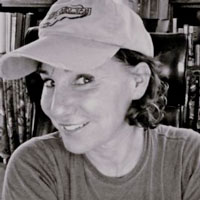
Nation
wide Call 817-599-0200
for current retail prices.
Hay USA Inc. feeds a wide variety of horses.
We supply hay for top performing horses, breeding facilities large and
small to the
back yard horse owner.
Our clients are educated and can not afford to take risks.
That is why they buy from Hay USA Inc.
Hay USA Inc. |
|
Business Hours 10 - 6 Tuesday - Saturday |
|



